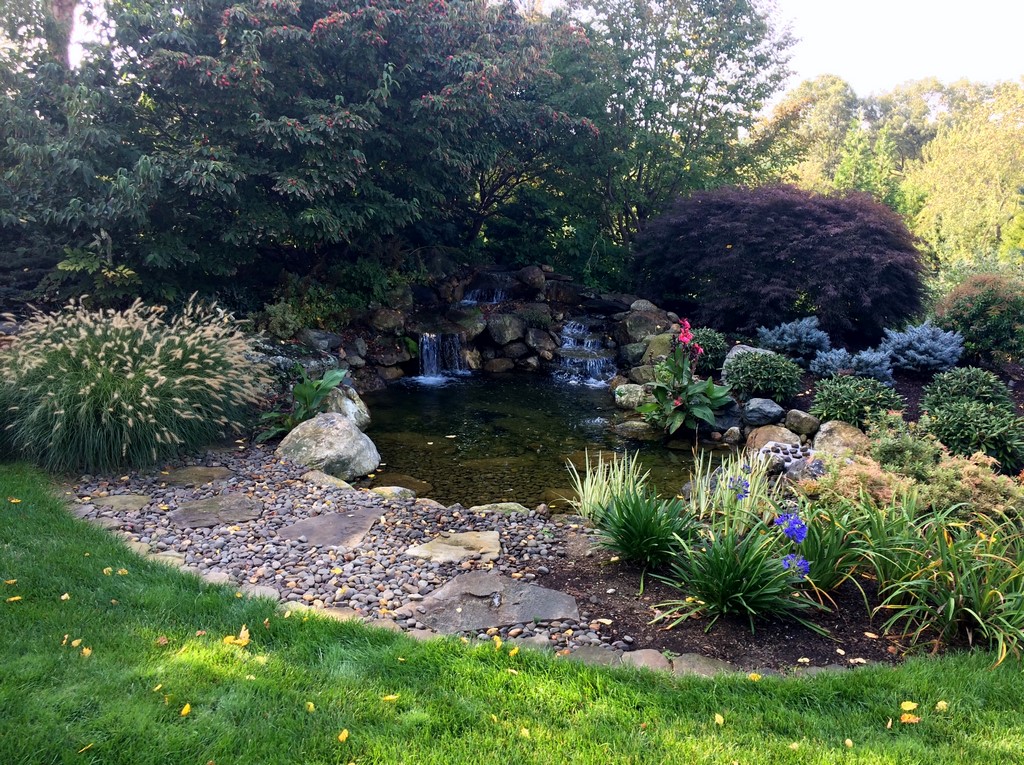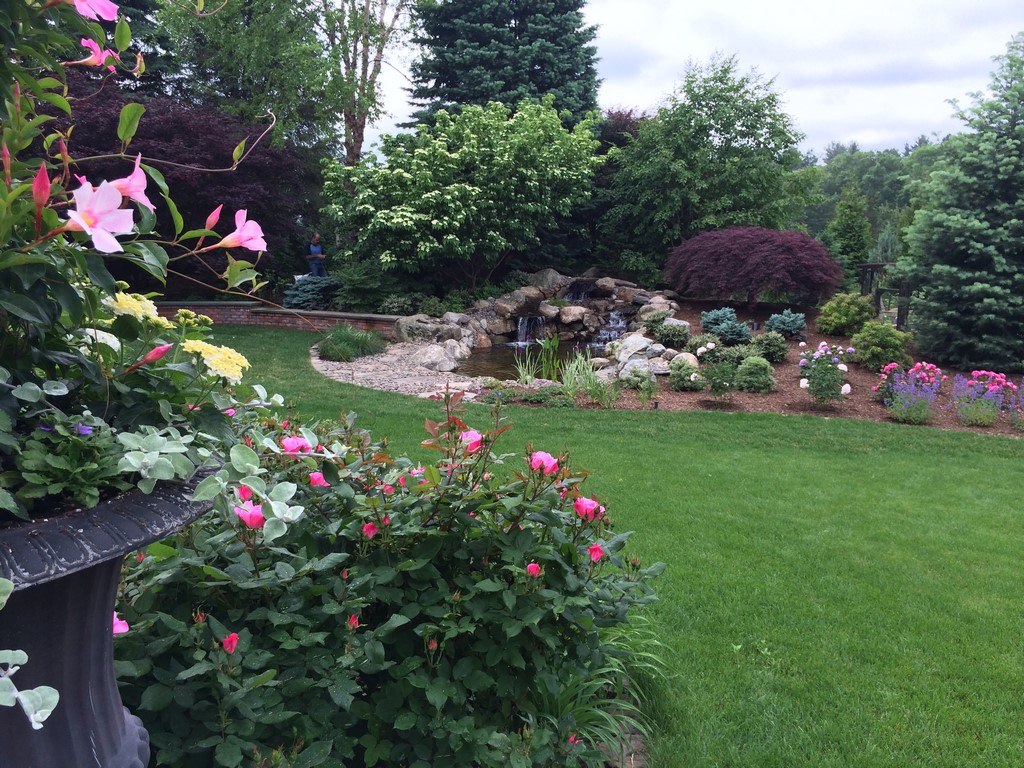Tools of Enchantment

‘I do not understand how anyone can live without one small place of enchantment to turn to.’
– Marjorie Kinnan Rawlings
As watershapers, we draw upon the sound and presence of water to soothe souls, using nature to guide and inform us.
In the small pond project featured here, for example, the watershape component of the composition is meant to reflect the amazingly random rock placements created by snowmelt: As it crashes down mountainsides, it carries and deposits its burden of rocks – from the largest boulders to the smallest pebbles – echoing as it goes the melodies created by other waterfalls as they gather, drop and ultimately provide homes for fish and plants.
On the landshaping side, my aim was to capture the planting patterns seen in the drifts and masses I’d previously established in this particular landscape. These recall the shapes of New England’s glacial mounds and have resulted in a garden space that pleases through all seasons and serves as a wondrous place of refuge.
The garden begins with the winter plantings so important where I live in New England. A good winter garden offers lovely views of color, form and texture to be enjoyed with snow and without. It also serves as a background for contrasts with seasonal flowers layered to offer an abundance of blooms in a planned sequence. This, too, is inspired by nature’s artful palette.
I devise all of this by using what I call my “tools for enchantment” – that is, my approach to designing with plants. As I see it, there’s an opportunity for enchantment with every project, a means of conjuring arrays of observations and sensations that draw observers near to linger, pause, indulge a range of sensory experiences, take deep breaths and know peace.
ORGANIZING PLANTS
Whether designing large, small or somewhere-in-between watergardens, our work is about creating beauty – the kind that enchants. One key to this task has to do with the organization of plant material: While holding the mature image of the garden-to-be in our minds, we arrange the planting patterns within the designed spaces.
Trees, shrubs, perennials, vines and annuals are the pieces of this interlocking and interrelating pattern. Each may be used by itself or in combination. Indeed, both individual placements and masses of these plants – linear curves and drifts – are the tools of our trade.
| The pond features multiple waterfalls, each contributing a unique set of sounds to the space, engaging the eye with variety and drawing observers near to see how everything works together. Once they get close, their sense of enchantment grows as they notice the fish gliding through the cool, clear water. |
In my own design practice, I begin this patterning exercise by placing plants as individuals and then expand them into masses, lines and drifts. It doesn’t much matter whether you use pencils, pens or a mouse: The setting grows into groupings of three, five, seven or nine as either natural polygon blobs or as geometric shapes (circles, squares or pentagons).
A square shape in plan view can become a cube in elevation, clipped or natural depending on your vision. Or there are sinuous lines of five to 12 plants, with the linear form of an “S” curve or its reverse becoming an effective framework for a doorway and directing the eye to a focal point – or perhaps establishing a winter pattern of shrubs in a perennial-planted garden space.
Drifts – which I think of as expanded triangles – are the shapes that happen when we cast handfuls of stones or bulbs. It’s also the planting pattern of colonization I observe most often in nature: You’ve seen it, I’m sure, that one daring individual leading the pack in a new direction, a determined territorial expansion.
As designers, we often use key individual plants to contrast, link, make statements, capture attention, stop observers in their tracks or otherwise cause a stir. We should also know that effective use of masses or drifts can stop those observers in their tracks as well – and that bold masses or drifts can be used architecturally to anchor, reinforce or build a space.
YEAR-ROUND DYNAMICS
An added bonus of such cohesion is that a little clutter in the form of a few intruding leaves or a weed or two doesn’t tilt the entire composition into chaos, disorder and general messiness. Instead, cohesion translates into a livable place that allows you to relax, enjoy, play and work in the garden easily versus submitting to the tyranny of a tightly designed space where the slightest deviation invokes an unruly sense of disorder.
Shrubs or “bushes” are an incredibly versatile tool in the sort of planting layouts I’m advocating here. I consider dwarf conifers, broadleaf evergreens and deciduous shrubs in the same design category: Their range of heights and widths, varying from 16 inches to about ten feet tall and/or wide, offers a broad band of possibilities.
| The backside of the watergarden’s mound (left) shows the white fir, the mass of red-stemmed variegated dogwood and a drift of dwarf fountain grass. From another approach (middle), the foliage of peony (left foreground), a mass of variegated iris and a drift of low-growing variegated pieris frame the pond, with the mass of dwarf fountain grass in the back taking your eye to the water. (Note the individual pink-flowered tropical canna: When you design with interlocking masses or drifts, you can add the occasional individual without breaking up the composition.) From the opposite direction (right), the view opens onto the mass of dwarf fountain grass and reveals the waterfalls. From here you see the burgundy foliage of the Japanese maple contrasting with low dwarf blue spruce and the white fir. You also see the variegated iris just beyond the beach with the drifts of daylily foliage, variegated pieris, pink roses, low-growing yak rhododendrons and pieris. In the background is a large drift of Joe Pye weed. |
Spring arrives at this watergarden with flowering bulbs, rolling into June with its flowering variegated iris, perennial geraniums, peonies and silver-leaved, blue-flowered catmint. Summer is a feast for the eyes, with the backlit, silvery, pinkish-white flower spikes of dwarf ‘Fountain Grass,’ daylilies, perennial geraniums and, later, blooming sedums. Moving forward, the pink-flowering sedum ‘Autumn Joy’ responds to the first frosts of fall, turning a carmine color to enrich the autumn palette.
Trees play instrumental roles in this watergarden, appearing as individuals and in groves or “tree colonies” of three or five or even more. These appear as tightly clustered groves or are spread here and there throughout the landscape as an “expanded” grove – as with the large, prominent white firs that appear in several spots spread widely around the landscape. I think of it as wind scatter or bird propagation – as instances of the same species finding success over wide areas. (I work to avoid single trees in my designs: Even in small spaces, I find ways to include at least a triad, widely placed or tight.)
| At right is a view of the pond garden planting, looking over the border. Burgundy-stemmed and -leaved bugbane (actaea s. ‘Burnette’) frames the view of the rose drift. At left is the view from the garden gate onto drifts of roses and dwarf fountain grass in the distant pond garden’s border. |
Trees, shrubs and perennials create stunning compositions when used in interlocking drifts and masses in planting patterns. Just remember to make sure the repeating patterns are visible from several vantage points: This brings a sense of unity as well as an appearance of abundance to the setting.
PULLING IT ALL TOGETHER
Scale is, of course, a consideration. In smaller gardens, for instance, you may need to use individuals with a mix of one or two small masses rather than crowds because of space limitations. But that doesn’t mean you abandon the strategy outlined here: Just remember to think about elevation patterns as well as plan patterns and that tall and mid-sized plants don’t need to be limited to spots in the middle and back. In fact, varying heights within a border adds mystery and creates microclimates.
For inspiration, look to native woodlands in laying out edge plantings with layered trees, shrubs and perennials. And for foundation planting within entry gardens, dining or play areas, reveal a tree’s form by using drifts, masses or linear strips of low shrubs (three feet tall and under) and by placing larger shrubs as backdrops behind the trees.
My focus here has been on plants instead of water, and that’s been deliberate: Most readers of WaterShapes know the dynamics of including ponds, streams and waterfalls in garden spaces and the importance of relying on local inspiration in developing a design. What I’m working toward here is a similar perspective on the plant side of the equation. It’s about designing with layers in mind by combining trees, shrubs and perennials together for color, texture, flowers and berries – and repeating these groupings as combinations at least three times within the landscape.
Yes, play with planting patterns – absolutely! – but avoid the use of too many varieties and running the risk of creating chaos instead of a mindful, meditative peacefulness. By varying the pieces of the planting puzzle to delight yourself and your client, you can reach past chaos, devise beautiful ways to draw observers into the watergarden and delight them with moments of safe, blissful peace.
Let the enchantment begin!
Maria von Brincken, APLD, owns and operates a full-service landscape design practice in Sudbury, Mass. Her award winning work has been published in Fine Gardening and is featured in Front Yard Idea Book (Taunton Press). She has also been interviewed and quoted by national newspapers, has appeared on local television and gives lectures at garden clubs, symposiums and conferences. She can be reached at [email protected].

















